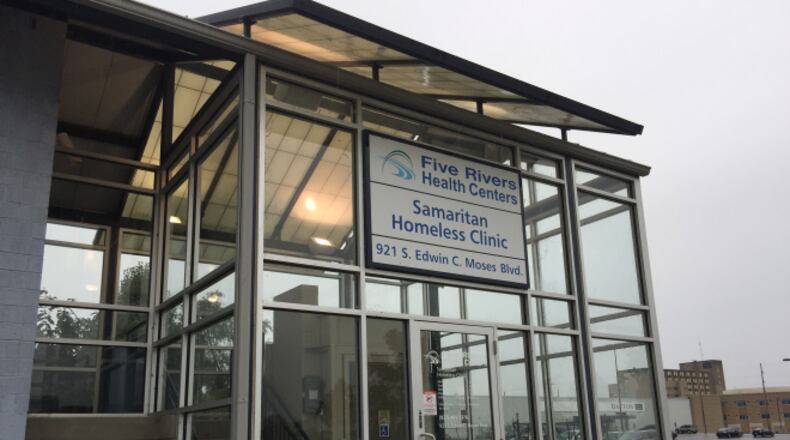According to the American Psychological Association, 47 percent of homeless women “meet the criteria for a diagnosis of major depressive disorder.”
This is also something that is happening close to home. The Treatment Advocacy Center said that, in Ohio, “36 percent of people released from mental institutions became homeless within six months.”
When asked about the most common mental illnesses among people living in poverty, Kenton Beachy, the executive director of Mental Health America in Franklin, said, “There are people with severe and persistent mental illness. Those who would be living with things like schizophrenia, bipolar disorder (and) anxiety.
“So, people who are persistently living with those mental illnesses are much more susceptible to the kinds of factors that lead to poverty.”
MORE FROM THIS PROJECT
» Poverty can be brought on by unforeseen problems
» How emotional poverty can be as powerful as financial struggles
Samaritan Homeless Clinic
Five Rivers Health Centers is a health care facility for low-income patients of Dayton. It has been in operation since May 2011.
In August 2015, the Five Rivers Health Center added the Samaritan Homeless Clinic. The goal of the clinic “is to do (its) part to improve the overall community while treating every patient who walks through our doors with dignity, respect, integrity, compassion and excellence.”
The Samaritan Homeless Clinic is one program that offers mental health counseling to Dayton’s homeless. According to its website, some of the mental health issues it offers assistance with are stress and anger management, relaxation and meditation training, dealing with loss, depression and crisis intervention.
The clinic practices integrated care, according to Diane Cummins, chief operating officer of Five Rivers Health Centers. This means when people come in for a medical appointment, they are also seen by a behavioral health consultant.
“They do screenings for anxiety and drug and alcohol abuse, for depression, and just a variety of different tools to say, ‘Does this person need more than we’re giving them?’ And then, if they screen positive for any of those things, then they will work with the patient on possible interventions,” Cummins said.
Interventions are only done if the patient is willing to pursue mental health or substance abuse care, Cummins said.
“We have two licensed social workers, a licensed professional clinical counselor, and (we) also usually have a substance abuse therapist,” Cummins said.
For those interested in ongoing care, based on the patient’s needs, the person will make an appointment with one of the clinic professionals or be referred to a professional from another mental health center, according to Cummins.
Lifestyle classes are offered to those who may be struggling with drug abuse, covering topics such as relaxation, exercise, self-care and sobriety.
“Those are open to all of our patients at any time, but, we might make a suggestion for someone to go to a class as well,” Cummins said. “Typically, they’re referred to one of the professionals that are here in the building for further follow up and care.”
There are people who come to the clinic for the counseling services, according to Cummins.
A report from the National Coalition for the Homeless said that, “According to the Substance Abuse and Mental Health Services Administration, 20-25 percent of the homeless population in the United States suffers from some form of severe mental illness.”
The Samaritan Homeless Clinic does not typically assist a person with a severe mental health illness.
“We do have a psychiatrist who’s here once a week, and she may start a patient with a severe mental illness on a medication until we can get them in, (because) waitlists for psychiatrists can be really long,” Cummins said.
“So she might do some bridge medication until we can get them hooked up, or, if it’s someone who is depressed, maybe just needs supportive counseling, she might put them on an antidepressant, work with the primary care provider to keep them on that medicine, and then hook them up with counseling in-house.”
Homelessness and mental health
The clinic served roughly 2,200 patients last year — about 40 percent of whom have some sort of mental illness or substance abuse diagnosis, according to Cummins.
Cummins said that substance abuse is the number one mental health issue that the clinic comes across. She said that they still treat it as a mental illness.
“Obviously it’s a different diagnosis, but it’s still all treated within the behavioral health realm,” Cummins said.
The second most common mental health issue the clinic comes across is depression. But with the depression comes an interesting question for those treating the patient.
“When you’re dealing with homeless patients, it’s hard to know whether they’re depressed because they’re homeless or they’re homeless because they’re depressed,” Cummins said.
The National Coalition for the Homeless notes that “people with (mental) illnesses are much more likely to become homeless than the general population.”
This illustrates that mental illness isn’t just something that happens to people who are already homeless — but it can be something that is actually the cause of a person’s homelessness.
About the Author
